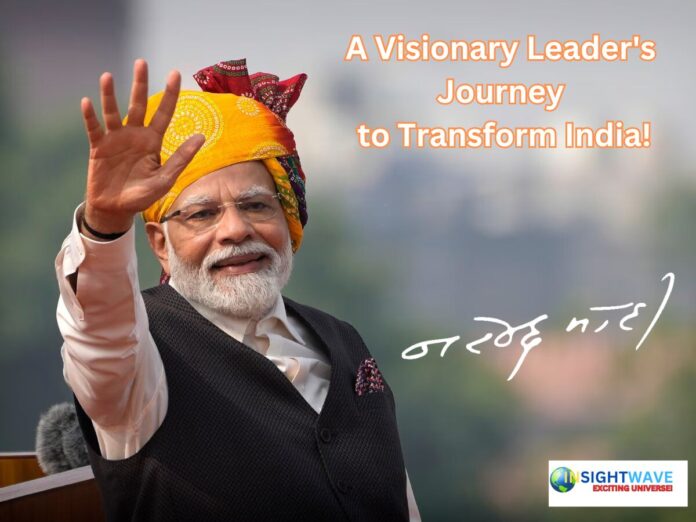Narendra Damodardas Modi, the 14th and current Prime Minister of India, is a man whose life story is a testament to the power of determination, resilience, and leadership. Born on September 17, 1950, in Vadnagar, a small town in Gujarat, India, Modi’s remarkable journey from humble beginnings to the pinnacle of Indian politics is a source of inspiration for millions. In this biography, we delve into the life, achievements, and the unique persona of Narendra Modi, a transformative leader who has left an indelible mark on India’s political landscape.
A Humble Beginning
Narendra Modi was born into a modest family of grocers. His early life in Vadnagar was marked by simplicity and frugality. Young Narendra helped his father at the family’s tea stall, gaining insights into the world of business and commerce from a young age. Despite the modest circumstances, he displayed a keen intellect and a strong determination to rise above his circumstances.
A Journey of Ideals
Modi’s early years were marked by a deep interest in spirituality and a commitment to social service. At the age of eight, he joined the Rashtriya Swayamsevak Sangh (RSS), a Hindu nationalist organization that played a significant role in shaping his ideological foundation. The values of discipline, selflessness, and patriotism that he imbibed during his RSS years would remain with him throughout his life.
The Political Ascent
Modi’s entry into politics was gradual but marked by unwavering dedication. He joined the Bharatiya Janata Party (BJP) in the early 1980s and quickly made his presence felt. His exceptional organizational skills and ability to connect with people earned him the respect and trust of his colleagues. In 2001, he became the Chief Minister of Gujarat, a position he would hold for four terms.
Under Modi’s leadership, Gujarat underwent significant economic development and growth. His administration’s focus on infrastructure, business-friendly policies, and investments in sectors such as manufacturing and technology transformed Gujarat into an economic powerhouse. The “Gujarat model of development” became synonymous with Modi’s governance.
The Gujarat Riots
Modi’s tenure as Chief Minister was not without controversy. The Gujarat riots of 2002, a period of inter-communal violence in the state, remain a deeply divisive and painful chapter in his political career. While his critics accused him of failing to control the violence, his supporters argued that he was unfairly targeted. The incident cast a long shadow over his image, both nationally and internationally, and continues to be a subject of debate and controversy.
The National Stage
In 2014, Narendra Modi embarked on a historic journey when he became the Prime Minister of India after the BJP’s resounding victory in the general elections. His campaign was marked by a promise of “Achhe Din” (Good Days) for India, focusing on economic growth, infrastructure development, and governance reform.
As Prime Minister, Modi introduced a series of ambitious initiatives, including “Make in India,” “Digital India,” “Swachh Bharat Abhiyan” (Clean India Campaign), and “Jan Dhan Yojana” (Financial Inclusion Program). These initiatives aimed to transform India into a global economic powerhouse, bridge the digital divide, improve sanitation and hygiene, and provide access to banking services for millions of unbanked citizens.
Economic Reforms and Challenges
Modi’s tenure saw the implementation of significant economic reforms, including the rollout of the Goods and Services Tax (GST), the demonetization of high-denomination currency notes, and initiatives to boost foreign direct investment. While these reforms aimed to streamline the Indian economy and curb corruption, they also faced criticism and challenges, particularly in their immediate aftermath.
Foreign Policy and Diplomacy
Modi’s foreign policy emphasized strengthening India’s global position and fostering strategic partnerships. He engaged in dynamic diplomacy, making high-profile visits to countries around the world and strengthening ties with major powers like the United States, Russia, and China. His “Neighborhood First” policy aimed to enhance regional cooperation and connectivity in South Asia.
One of the defining moments of his foreign policy was the “Howdy, Modi!” event in Houston, Texas, in 2019, where he shared the stage with then-U.S. President Donald Trump in front of a massive Indian-American audience, highlighting India’s growing influence on the world stage.
Challenges and Criticisms
Modi’s leadership has faced its share of challenges and criticisms. His administration’s handling of issues such as farmer protests, religious tensions, and press freedom has drawn criticism from various quarters. Critics have also raised concerns about the centralization of power and the erosion of democratic institutions.
Re-election and COVID-19 Crisis
In 2019, Narendra Modi secured a resounding re-election victory, signaling widespread support for his leadership. However, his second term began with an unprecedented challenge—the COVID-19 pandemic. The pandemic posed a severe health crisis, straining India’s healthcare infrastructure and economy. Modi’s government faced criticism for its response to the crisis, but it also undertook vaccination drives and relief efforts to combat the virus’s impact.
The Legacy and Beyond
His leadership continues to shape India’s trajectory, and he remains a polarizing figure in Indian politics. His legacy is defined by his vision for a “New Bharat” and his commitment to transforming the nation’s socio-economic landscape.
Conclusion
Narendra Modi’s life and career epitomize the idea that one can rise from humble beginnings to the highest echelons of power through dedication, resilience, and a clear vision. His journey from a small town in Gujarat to the Prime Minister’s residence in New Delhi reflects the aspirations and dreams of millions in India.
While Modi’s leadership has been marked by significant achievements and ambitious reforms, it has also faced criticism and challenges. His impact on India’s political and economic landscape is undeniable, and the legacy he leaves behind will continue to shape the nation’s future.
As India and the world watch the next chapters of Narendra Modi’s leadership unfold, his story remains a source of inspiration for those who believe in the power of individual determination to effect change on a grand scale.


